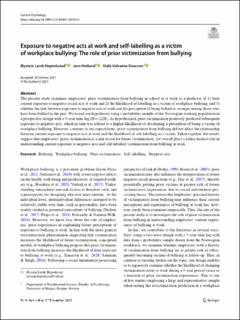| dc.contributor.author | Hoprekstad, Øystein Løvik | |
| dc.contributor.author | Hetland, Jørn | |
| dc.contributor.author | Einarsen, Ståle Valvatne | |
| dc.date.accessioned | 2022-02-01T07:58:25Z | |
| dc.date.available | 2022-02-01T07:58:25Z | |
| dc.date.created | 2021-11-25T18:10:58Z | |
| dc.date.issued | 2021 | |
| dc.identifier.issn | 1046-1310 | |
| dc.identifier.uri | https://hdl.handle.net/11250/2976159 | |
| dc.description.abstract | The present study examines employees’ prior victimization from bullying in school or at work as a predictor of 1) their current exposure to negative social acts at work and 2) the likelihood of labelling as a victim of workplace bullying, and 3) whether the link between exposure to negative acts at work and the perception of being bullied is stronger among those who have been bullied in the past. We tested our hypotheses using a probability sample of the Norwegian working population in a prospective design with a 5-year time lag (N = 1228). As hypothesized, prior victimization positively predicted subsequent exposure to negative acts, which in turn was related to a higher likelihood of developing a perception of being a victim of workplace bullying. However, contrary to our expectations, prior victimization from bullying did not affect the relationship between current exposure to negative acts at work and the likelihood of self-labelling as a victim. Taken together, the results suggest that employees’ prior victimization is a risk factor for future victimization, yet overall plays a rather modest role in understanding current exposure to negative acts and self-labelled victimization from bullying at work. | en_US |
| dc.language.iso | eng | en_US |
| dc.publisher | Springer | en_US |
| dc.rights | Navngivelse 4.0 Internasjonal | * |
| dc.rights.uri | http://creativecommons.org/licenses/by/4.0/deed.no | * |
| dc.title | Exposure to negative acts at work and self-labelling as a victim of workplace bullying: The role of prior victimization from bullying | en_US |
| dc.type | Journal article | en_US |
| dc.type | Peer reviewed | en_US |
| dc.description.version | publishedVersion | en_US |
| dc.rights.holder | Copyright The Author(s) 2021 | en_US |
| cristin.ispublished | true | |
| cristin.fulltext | original | |
| cristin.qualitycode | 1 | |
| dc.identifier.doi | 10.1007/s12144-021-02453-5 | |
| dc.identifier.cristin | 1959346 | |
| dc.source.journal | Current Psychology | en_US |
| dc.identifier.citation | Current Psychology, 2021. | en_US |

